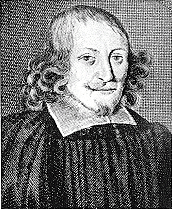<Back to Index>
- Astronomer Jean Felix Picard, 1620
- Painter Emil Orlík, 1870
- Poet and Diplomat Vasile Alecsandri, 1821
PAGE SPONSOR

Jean-Felix Picard (July 21, 1620 – July 12, 1682) was a French astronomer and priest born in La Flèche, where he studied at the Jesuit Collège Royal Henry-Le-Grand. He was the first person to measure the size of the Earth to a reasonable degree of accuracy in a survey conducted in 1669 – 70, for which he is honored with a pyramid at Juvisy-sur-Orge. Guided by Maurolycus's methodology and Snellius's mathematics for doing so, Picard achieved this by measuring one degree of latitude along the Paris Meridian using triangulation along thirteen triangles stretching from Paris to the clocktower of Sourdon, near Amiens. His measurements produced a result of 110.46 km for one degree of latitude, which gives a corresponding terrestrial radius of 6328.9 km. The polar radius has now been measured at just over 6357 km. This was an error only 0.44% less than the modern value. This was another example of advances in astronomy and its tools making possible advances in cartography. Picard was the first to attach a telescope with crosswires (developed by William Gascoigne) to a quadrant, and one of the first to use a micrometer screw on his instruments. The quadrant he used to determine the size of the Earth had a radius of 38 inches and was graduated to quarter minutes. The sextant he used to find the meridian had a radius of six feet, and was equipped with a micrometer to enable minute adjustments. These equipment improvements made the margin of error only ten seconds, as opposed to Tycho Brahe's four minutes of error. This made his measurements 24 times more accurate. Isaac Newton was to use this value in his theory of universal gravitation.
Picard also travelled to Tycho Brahe's Danish observatory, Uraniborg, in order to assess its position accurately so that Tycho's readings could be compared to others'.
Picard collaborated and corresponded with many scientists, including Isaac Newton, Christiaan Huygens, Ole Rømer, Rasmus Bartholin, Johann Hudde, and even his main competitor, Giovanni Cassini, although Cassini was often less than willing to return the gesture. These correspondences led to Picard's contributions to areas of science outside the field of geodesy, such as the aberration of light he observed while in Uraniborg, or his discovery of mercurial phosphorescence upon his observance of the faint glowing of a barometer. This discovery led to Newton's studies of spectrometry.
Picard also developed what became the standard method for measuring the right ascension of a celestial object. In this method, the observer records the time at which the object crosses the observer's meridian. Picard made his observations using the precision pendulum clock that Dutch physicist Christiaan Huygens had recently developed.
His book "Mesure de la Terre" was published in 1671.
There is a lunar crater named after Picard, on the northwest quadrant of Mare Crisium. The PICARD mission, an orbiting solar observatory, is named after Picard.